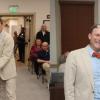Carbine used at Little Bighorn makes its way to Lewes
In his 53 years as a licensed Delaware dealer, Charlie Steele has displayed and sold a wide variety of historic, antique, used and brand-new guns. None, though, ranks above the Springfield 4570 trapdoor carbine now in his possession and on display at his Route 9 gun shop west of Lewes.
“It’s a gun that was used in the Battle of the Little Bighorn,” said Charlie in a recent interview.
That’s the infamous battle of June 25 and 26, 1876, in Eastern Montana that pitted soldiers, troopers and scouts under the command of Maj. Gen. George Armstrong Custer against members of the Sioux, Lakota and Cheyenne tribes.
Historians tell us that Custer’s forces, seriously outnumbered and outgunned in the two-day battle, were routed by the tribesmen. It’s estimated that 210 soldiers of the Seventh Cavalry along with 250 troopers and scouts lost their lives, compared to the 40 or 50 Native Americans killed in the fighting. Custer was among those killed.
The Springfield Trapdoor 4570, according to a variety of sources, is thought to be one of the reasons why the soldiers were outgunned. The 4570 number refers to the caliber of the lead ball at the tip of the cartridge fired by the rifle – .45 – and the 70 grains of black powder in the cartridge.
Though the Springfield and a Colt .45 six-shot pistol were standard-issue U.S. weapons of the day, the Springfield was still only a single-shot carbine rifle – basically a retooled muzzleloader of the type used in the Civil War. The trapdoor feature refers to a breech block on top of the hammer end of the barrel that pops open to allow a .45 caliber cartridge to be placed in the breech. When the trapdoor was closed, the cartridge was then in position to be struck and fired by the pull-back hammer of the former muzzle-loader.
It’s estimated the Springfields could be fired with accuracy – up to 300 yards – at a rate of about 12 to 15 times per minute. But that’s nothing compared to the rapid-fire shooting rate of the Winchester and other lever-action repeating rifles used by tribal warriors in the battle.
Montana to Lewes
So how did one of the Springfield carbines used at Little Bighorn make its way into Steele’s Gun Shop?
“The owner of the gun heard through the grapevine that I’m interested in Civil War guns and memorabilia. He’s a relative of a man in Odessa who collected all kinds of photographs, prints and other artifacts from the Civil War. When the man died, the relative brought me boxes and boxes of old photos and prints, letters and all kinds of other stuff from the Civil War to see what it might be worth. Included in the collection were an 1878 book about Custer, photos of the general and his wife, Winnie, rosters of the men killed in the battle and copies of letters sent to General Sherman.”
One day not too long ago, Steele sat down to go through some of the boxes. He came across an envelope that piqued his curiosity. It included a letter referring to the Springfield 4570.
“I called him up and asked him about the gun,” said Steele.
“‘I’ve got this old rifle here,’ he said, and it turns out it was one of the Springfields used in the battle. Pretty good shape, too. No rust, no pits. You could still fire the hell out of it of you wanted to.”
Included in the envelope were notarized confirmation letters testifying to the authenticity of the carbine and its history, including references to its 42542 serial number. “That’s definitely in the range of the guns used by troops at Little Bighorn,” said Steele.
The letters relate how a Custer historian named John Carroll bought the Springfield in 1980 from the owner of a store near the river where a road leads to the battlefield. “The store owner’s name was Kiah Buckner, and he bought the gun from a Sioux Indian who said the gun had been used by the Seventh Cavalry and had been picked up after the battle and lay hidden for years, in the family for several generations,” said Steele. “It was part of a collection of other stored items including a Ghost Dance shirt, Indian clothing and other weapons.” Carroll, said Steele, sold the gun to the Odessa resident.
As a seller of lots of guns taken on consignment, Steele said discussions are still going on about how best to market the historic gun.
There’s lots of interest from auctioneers who would like to sell just the gun and its pedigree documents. “But I’d rather see all of it go as a whole collection,” said Steele. “It’s amazing history.”
In the meantime, Steele has the Springfield, and many related documents, mounted in a museum-like display in his shop, not far from one of the guns used by a member of the Dalton Gang in the infamous Coffeyville, Kansas bank robbery shootout in 1892.
“People are welcome to come by and take a look,” he said.






















































